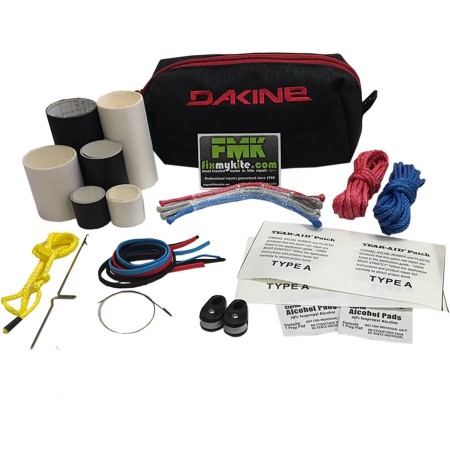Need new bridle line? Click Here
The Leading edge and strut casing is made of Dacron. Dacron is a condensation polymer obtained from ethylene glycol and terephthalic acid. Its properties include high tensile strength, high resistance to stretching, both wet and dry, and good resistance to degradation by chemical bleaches and to abrasion. The continuous filament yarn is used in curtains, dress fabrics, high-pressure fire hoses, men's shirts, and threat. Dacron is used because of these characteristics.
Most leading edge and strut damage is from being drug on something or be crashed very hard. Leading edge and strut casing are harder to repair because the bladders put pressure on the Dacron. The best way to repair this kind of damage is to get it repaired by a professional repair center.
One of the best ways to repair leading edge and strut if you don’t have any access to a professional repair center is using Kitefix Fiberfix and sticky back Dacron. Combining the two will hold the load of the bladder.
Bladders also need repairs time to time either having a pin hole or major blowout. If the bladder can be patched the best way is to use tear-aid type A. TEAR-AID® repair patch is made from an exceptionally tough, matte finish, abrasion resistant, elastomer that resists puncture and tearing. It is combined with an aggressive adhesive formulated for high bond strength to a variety of surfaces such as canvas, leather, rubber, nylon, most plastics, paints, aluminum, stainless steel, fiberglass, polyurethane, polyethylene, polypropylene, vinyl and vinyl coated. TEAR-AID® provides a simple and easy method of patching holes and tears, as well as an excellent protective film solution. Tear-aid has many different uses. When using tear-aid you want to make sure that the area is clean of salt and dirt and completely dry. You want to make sure that the bladder is completely flat. Once you put the tear-aid you want to make sure that there are no wrinkles going to the edge of the tear-aid patch to leak out of.
If the bladder is too damaged to repair fixmykite.com has all the bladder blanks and valves you would need to build a replacement bladder. We use PU (polyurethane) bladders which are in every kite out there on the market. PU is used because it stretches and forms to the kites casing. Other companies out there use plastic bladder blanks which are harder to install and do not form well to the kites casing.
The cause of most sail cuts/damage is laying/landing the kite on sharp objects or dragging the kite. Make sure when you are having someone launch your kite that they do NOT drag the kite when getting ready to launch. There is four common ways to repair the sail material.
1. Having a Professional Repair center repair your kite
To get a kite repaired properly you should send it to a professional repair center. The common ways repair centers repair a sail is using a sail tape and sew it. Another way is to do a panel replacement which replaces the damaged area with new sail material. Most repair centers will have some type of guarantee. Here at fixmykite.com guarantee our repairs for the life of the kite.
2. Using Sail Tape if damage is under 2”
Sail tape is a ripstop tape that has an adhesive backing that comes in different colors and sticks to the sail material. Sail tape comes in a 2” wide tape or 1” wide. For best results is to clean the area of salt water and dirt and let it dry completely. When using sail tape you will be using two pieces. One piece of sail tape will be on the top side and the other will be put on the bottom side. The sail tape should be cut so that the sail tape covers at least a ¾” away from the sail damage. See picture below. The sail tape is a temporary fix until you have the means of getting your kite fixed professionally.
3. Using Kitefix Ripstop Repair kit for sail cuts/damage
Kitefix ripstop repair kit is a kite repair kit that uses fiberfix and glufix to repair kites. Here at Fixmykite.com we like using the kitefix ripstop repair kit if we are somewhere that does not have access to a professional repair center. The kitefix ripstop repair kit is fairly simple to use and is very strong.
4. Using Tear-Aid
TEAR-AID® repair patch is made from an exceptionally tough, matte finish, abrasion resistant, elastomer that resists puncture and tearing. It is combined with an aggressive adhesive formulated for high bond strength to a variety of surfaces such as canvas, leather, rubber, nylon, most plastics, paints, aluminum, stainless steel, fiberglass, polyurethane, polyethylene, polypropylene, vinyl and vinyl coated. TEAR-AID® provides a simple and easy method of patching holes and tears, as well as an excellent protective film solution. Tear-aid has many different uses. Here at fixmykite.com we use tear-aid to repair bladders. If you find yourself in a position where you do not have access to a professional repair center tear-aid works really well. To apply tear-aid is very similar to the sail tape but you only need to use one patch instead of two. Clean the area of salt and dirt and let completely dry. Then apply the tear-aid over the damaged area.


